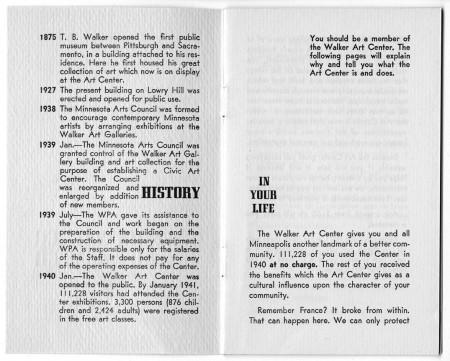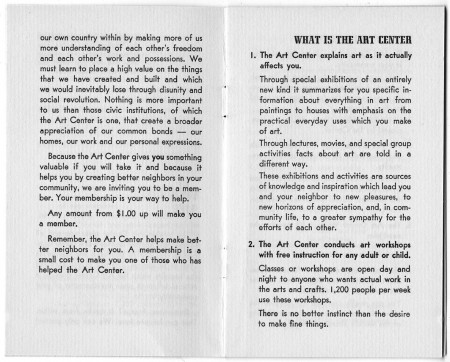Remember France? It broke from within. That can happen here. We can only protect our own country within by making more of us understanding of each other’s freedom and each other’s work and possessions. We must learn to place a high value on the things that we have created and built and which we would inevitably lose through disunity and social revolution. Nothing is more important to us than those civic institutions, of which the Art Center is one, that create a broader appreciation of our common bonds — our homes, our work, and our personal expressions.
The London-based Polish artist Goshka Macuga uses the history of the Walker—from founder and lumber baron T.B. Walker to the Herzog and de Mueron expansion in 2005—to prompt a larger examination of the relationship between civic institutions and the communities that they serve. The quote above appears in a fund-raising brochure from the 1940s, and invokes the invasion of France by Germany as warning that if there was no effort to foster relationships and better understanding between different communities (whether cultural, political or economic), our “greater sympathy” would break and give way to disunity and social revolution as it was doing so rapidly in Europe at the time. This text became the source of the title of Macuga’s first solo-exhibition in the United States, Goshka Macuga: It Broke from Within, and helps frame her investigation into the Walker’s endeavors, both benign and controversial, and its connection to the Twin Cities and Minnesota.


Walker Art Center membership drive brochure, 1941
It Broke from Within is composed of a number of different elements, all of them the product of her research here at the Walker in April 2010. At the far end of the gallery is the centerpiece of the exhibtion: a large 48 foot woven tapestry, bringing together images and elements from her search in the archives against the backdrop of the Lost Forty, a parcel of land in northern Minnesota spared from the aggressive lumber industry in the 19th century due to a surveying error, making it one of the few old-growth forests left in the state. A raised platform in front features sunken areas for seating, which were based on an early Herzog and de Mueron sketch of Cargill Lounge with communal pits that was never realized. On the other side of the gallery, a collection of objects and archival pieces from our own collection displayed in custom frames (pictured above) based on a work by Sherrie Levine.
Installation view of the exhibition
This exhibition also marks a special collaboration between a visiting artist and the design department. The tapestry, while composed by Goshka, was composited by our senior imaging specialist Greg Beckel, and the photographic backdrop of the forest was shot by photographer Cameron Wittig, who accompanied the artist during her second visit to Minnesota in October 2010. Both Greg and Cameron will post more about the technical aspects of producing a tapestry of this size, and the experience of photographing the Lost Forty. A booklet, mainly organized by Macuga, and co-curators Peter Eleey and Bartholomew Ryan, was also included as a component to the exhibition, which includes an interview with the artist about her time here and thoughts about her practice and the Walker, as well as texts that examine some of the issues surrounding our institutional history. The publication also includes some of the archival material which Macuga uses in the tapestry, as well as a key to the piece itself. It is free and available to visitors in the gallery.
As a document that will be in our own archives for years to come, I’m personally interested in how this publication will be viewed in the future, and whether or not we’ve been true to the promise of providing sources of “new pleasures, to new horizons of appreciation, and, in community life, to a greater sympathy for the efforts of each other.”
Goshka Macuga: It Broke from Within is on view in Burnet Gallery until August.
Get Walker Reader in your inbox. Sign up to receive first word about our original videos, commissioned essays, curatorial perspectives, and artist interviews.












